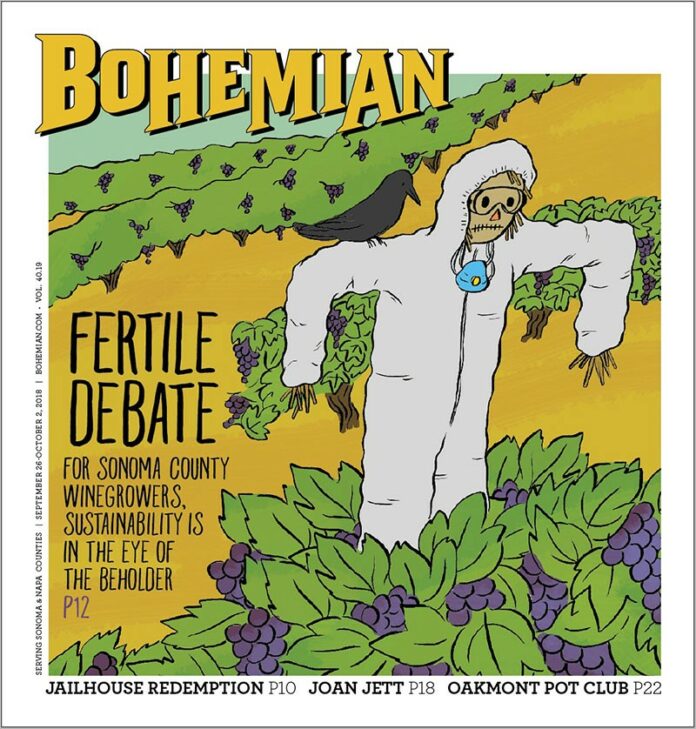‘What are you doing to my wine?”
That’s what Karissa Kruse, president of the Sonoma County Winegrowers, heard from more than a few consumers in response to the organization’s ambitious sustainability initiative. The voluntary program is aiming to make Sonoma County the nation’s first 100 percent sustainable wine region by the year 2019.
The organization says it’s taking on the project to ensure the long-term viability of grape growing and agriculture in Sonoma County, but also to help move the region a peg up in the global marketplace.
Consumers do not reward organic labeling the same way they do when shopping for food and other products, and, apparently, some people confuse “sustainable” and organic wine, which was just too darn crunchy for them.
“Historically, we’ve seen that more around biodynamics and organics,” Kruse says. “There’s been some consumer confusion—that the practices that go into it impact the taste of the wine.” In other words, people were making the age-old association of dirt with “dirty.”
But increasingly, consumers are getting a new message: sustainability is green, and “clean.” The feedback they’re getting to questions like, “Why would you buy sustainable wine?” is the opposite, Kruse says. “It’s because they think the quality is better.”
The five-year sustainability plan was launched in 2014. As 2019 approaches, Sonoma County winery and vineyard operators have implemented progressive environmental and personnel development projects too numerous to list here.
But as the Sonoma Sustainable label rolls out to consumers, are wineries aiming to have their Chardonnay and drink it, too—passively benefiting from the positive messaging of organic farming practices while evading inconvenient prohibitions on fertilizers and pesticides?
In recent years, I’ve noted a war of words in discussions about organic and sustainable certifications that does not seem necessary. It’s not enough to tout the benefits of one; the other must also be put down. Sometimes, those who favor organics complain that when a winery says it’s sustainable, it doesn’t mean anything. More often, winery representatives tell me that sustainability “goes beyond organics.” I was once told, in all earnestness, that sustainable farming only selectively targets pests, like a smart bomb, while, “in organics, they kill everything!”
It isn’t the Sonoma County Winegrowers pushing this view. “We have growers that are organic and biodynamic and sustainable,” Kruse says. “And they’re all good. Any time farmers are focused on what they’re doing is good. I think people try to pit the programs against each other, and I don’t think that’s fair to the farmers who are trying real hard to do the right thing.”
The Winegrowers’ reports on the initiative’s progress published since 2015 do a great job of explaining their goals, and include many profiles of local growers and ag leaders who have found cost savings or other benefits by implementing best practices in energy use, habitat and human resources. It’s worth noting that the reports make minimal mention of organic or biodynamic certified vineyards. For example, one report discusses how Ridge Vineyards uses cover crops, but doesn’t say the vineyards are certified organic.
What does it mean to be sustainable for the Winegrowers? Is it more than just marketing? To get a better idea of the nuts and bolts of the program, I sat down with former Winegrowers sustainability manager Emily Farrant last year to discuss the grape growers’ self-assessment, the first step of the certification process. She’s now an independent auditor of the program.
To become Sonoma Sustainable, there are four ways to go. The California Sustainable Winegrowing Alliance certification program is the main standard the Winegrowers use. Three other programs with their own rules are also accepted: Fish Friendly Farming, Lodi Rules and Sustainability in Practice. Organic certification will not get you a Sonoma Sustainable seal of approval.
Here’s how it works: the workbook has 16 chapters, each dealing with an aspect of vineyard management, human resources, winemaking practices and other topics. Each section contains a series of statements in four categories, and respondents are asked to choose which category best describes their operation.
For example, in section 7-5 on wine quality, answering “Knowledge of wine quality consisted of only tasting local wines or none at all,” will get you category 1. The better answer is, “Wine regions elsewhere in the state and internationally had been visited and toured,” one of three prerequisites for best-practices category 4.
In section 3-3, on leaf removal, category 2 states, “Leaf removal was sometimes done, or very lightly done, to minimize costs.”
Most of the best-practices answers here have been taught for decades as simply good, modern farming. Doing just a little better than showing up will earn a category 2.
But growers cannot hang out in category 2 forever and be re-certified, Kruse says. “Every year, you’re having to do something, whether lowering water use or doing something for employees. You have to do something that shows you’re moving the needle in one of the assessments.” Continual improvement is the mantra of the program.
[page]
Best practices guide growers to use fewer chemicals, but they are not prohibited.
All of this isn’t free, except for the initial self-assessment paperwork. After that, administration fees and auditing costs can run up hundreds of dollars—small change for big wineries, but a burden for small growers. Currently, Winegrowers is offering to help defray costs. Also, it’s holding up the notion that consumers will be willing to pay a buck or two, even $7 and change, according to one Wine Intelligence survey, for wines that bear a sustainable label.
Now that I know what the Sonoma County Winegrowers mean by sustainable wines, what do those consumers know?
Not much. Glance at any number of cheery articles about sustainable and organic wine, and you’ll often find the terms used interchangeably. According to consumer research commissioned by the Winegrowers in 2017, a higher percentage of frequent premium wine consumers would be more likely to buy a certified sustainable wine than could identify what it means.
A 2018 report issued by the nonprofit Wine Market Council finds that almost the same portion of respondents who felt “fairly confident” about the meaning
of “sustainably produced wine,”
43 percent, also believed it meant “no use of synthetic pesticides/fertilizers,” at 45 percent. That’s incorrect, and is actually the definition of wine made from organic grapes, which 87 percent did get right.
But while an equal number agreed that sustainably produced wine “conserves local water resources and habitat,” only 17 percent agreed that “wine made from organic grapes” does the same. While the updated National Organic Program standards contain a number of points on soil stability and water quality, along with wildlife and woodland conservation, perhaps the perverse takeaway from informal interactions with sustainability promoters like I have had is working. Do wine consumers think that organic standards don’t protect the environment?
A 2017 report from Liz Thach, professor of wine at Sonoma State University, finds that among 301 wine consumers surveyed with the question “What appeals most to you,” statements about sustainable wine beat those about organic wine at 44 percent to 20 percent.
The phrasing of the statement is interesting. “Certified sustainable wine: made in a way that is environmentally friendly, equitable to employees and economically viable to winegrowers. No agri-chemicals are applied, unless necessary to save the crop.” The first three parts mirror the “triple bottom line” approach of the Winegrowers, the so-called three
p‘s of “people, planet and profit.” The fourth is something of a misrepresentation of the certification requirements, failing to acknowledge the routine use of what you might call the fourth p—pesticides.
Mention that in the feel-good context of the sustainability initiative, and you might as well be tagged with two more p‘s, for party pooper.
About the above survey, Kruse makes an oft-heard argument: “Organics uses pesticides and chemicals, too—so it’s the same definition.”
Organic and biodynamic growers are allowed to use certain products that kill bugs or inhibit mildew, but qualitatively, the chemistries are different. In 2017, the California Sustainable Winegrowing Alliance issued an addendum to the workbook: a “red list” of 28 materials that are prohibited in the second year of certification, and a “yellow list” of 10 chemicals that may be accepted if justification is provided.
Red list materials that were used in 2016 in some Sonoma County vineyards, according to pesticide use reports (PUR) available from the California Department of Pesticide Regulation, include carbaryl, mancozeb and zinc phosphide. Yellow list materials included 2,4-D, abamectin, diphacinone, paraquat dichloride and simazine.
Notably absent from the 2016 PUR is chlorpyrifos, a nerve agent that was banned for home use 17 years ago, but wasn’t prohibited outright until this summer when the Ninth Circuit court overturned former EPA administrator Scott Pruitt’s efforts to keep the substance legal. Yet in this past year, chlorpyrifos turns up under the brand name Lorsban in several Sebastopol locations—used on apples as well as wine grapes, by the way.
Diphacinone is a tricky substance. This anticoagulant rodenticide can be fatal to the very rodent-hunting owls that the sustainability code recommends building nest boxes for, if operators choose to double down and employ both methods.
Glyphosate, a systemic herbicide better known by its Monsanto brand name Roundup, has come under increasing scrutiny. It was named a probable human carcinogen by the World Health Organization, and was recently banned from use in parks by Santa Rosa and Windsor due to public concern. It’s widely used to keep vineyards weed-free.
[page]
If consumers are to believe that Sonoma County is now using such chemicals only when necessary, or are committed to decreasing their use, what’s the record been since the Winegrowers launched its sustainability initiative four years ago?
We’re up, we’re down, but there is no dramatic downward trend, according to DPR statistics. In 2014, 76,975 pounds of glyphosate were applied in Sonoma County; 92,698 pounds in 2015 and back down to 76,890 pounds in 2016.
A comparison to other grape-growing counties does not indicate that Sonoma is reining in the Roundup, even compared to Fresno County, which put on 65,577 pounds on wine grape acreage in 2016. (To be sure, Sonoma County grape growers are not in the same league as Fresno almond growers, who put 68,081 pounds of chlorpyrifos on their trees in the same year.)
Hoping to gain insight from a longtime West County winegrower who’s surrounded by neighbors in the Green Valley of the Russian River Valley region, I ask Joy Sterling, partner and CEO of Iron Horse Vineyards, for her thoughts on the sustainability program. “I think it’s better,” Sterling says. “You can be organic and not be sustainable.”
A local leader in green practices, Iron Horse has irrigated its 164-acre estate with recycled Forestville water since 1990 and is certified by Fish Friendly Farming.
But I’ve hardly begun to ask about the misgivings some county residents have about farming inputs, when Sterling says she’s become depressed, comparing them to the protesters at the recent Climate Summit. “It’s never enough for some people,” she sighs. “We do our very best.”
Up on Sonoma Mountain, vintner Tony Coturri is also dismayed, for a different reason: he didn’t realize that people elsewhere are still spraying paraquat. “I’m just amazed. That’s just amazing to me. Wasn’t that Agent Orange?”
Coturri’s out of the loop with his five acres of uncertified vineyards farmed without chemical inputs, however. While his wines have gained recognition in the natural wine bars of New York City and Los Angeles he says he doesn’t register with Sonoma County Winegrowers.
“Nobody’s talked to me,” Coturri says. “I’m pretty much a pariah in the business.”
Like Coturri, other organic and biodynamic winegrowers I talked to acknowledged that farming without modern systemic chemicals involves trade-offs, like more tractor passes in the vineyard to control mildew.
“There’s a little give and take there, sure,” says Sophie Drucker, vineyard manager at Boisset Collection. “But I think it’s overstated to say we’re polluting the environment because we’re farming organically.”
Drucker says that, for her, it amounts to an extra tractor pass or so per year. “But organic sets a higher standard and is much more limiting as far as what tools you have to accomplish your farming.” Boisset Collection, which includes DeLoach Vineyards, also got certified sustainable, but pays a premium to its contracted growers for organic grapes.
Dry Creek Valley’s Ferrari-Carano Vineyards isn’t known for its biodynamic practices, yet vineyard operations manager Todd Clow says that the winery’s sustainability efforts have encouraged him to work on a proposal to achieve a biodynamic certificate for a small vineyard in an environmentally sensitive area.
“The cynic in me,” Clow says, “agrees with people’s misgivings about the sustainable certification, because there are holes in the program.”
Although Ferrari-Carano farms over a thousand acres conventionally, it is among those operations working to move away from Roundup, Clow says, as well as proactively aiming for category 3 and 4 sustainability targets. “From what I’ve seen in the last decade, we’ve made a lot of progress, and we have a lot more progress to make.”
Still, says Clow, “we can’t apply biodynamic or organic farming principles to 1,500 acres; we wouldn’t be in business if we did that.”
In Sebastopol, winegrower Paul Sloan is undecided on the sustainability program, slowing down in the midst of a busy harvest to ponder the question. Sloan agrees that organic wine carries a stigma that is lagging 20 years behind the larger marketplace. But he says he farms his Small Vines vineyard, where his family also lives, with only organically approved inputs for reasons of wine quality and environmental health, not for marketing purposes.
If he was asked to self-assess for the sustainability initiative, which he says he hasn’t been so far, Sloan is philosophical.
“It’s a waste of my time, but it is possible that it is better for the whole of the growing community, for me to go though the process,” Sloan says. “Or maybe I stand on the soapbox a little bit. I don’t want to be a negative to the whole, but at the same time I don’t think this has gone far enough. It’s a pretty good step in the right direction, but it’s not enough—it’s just one step in the process.”
Winegrowers president Kruse says that some growers are so committed to eventually taking extra steps to best-practices categories in the sustainability code, that they ask her, “What if we max out everything we can do to improve?” Kruse says. “Well, I hope we get there.”















